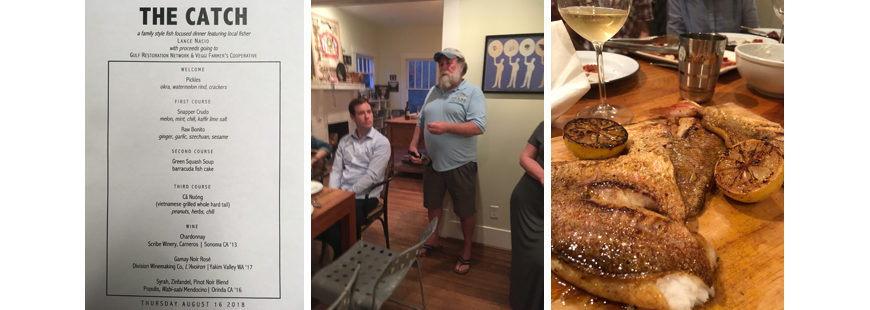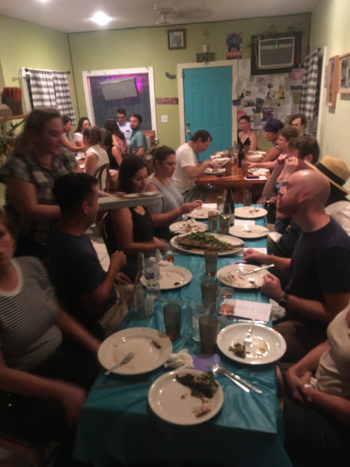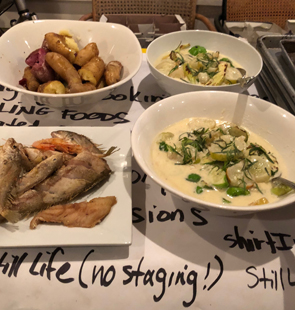As a fisheries organizer, there’s one question I get at almost every public event I’m a part of: “What is one thing that I can do to help fish and fishermen?”
It’s a tough question to answer and one that I’m sure I will hear a lot during this October, which happens to be National Seafood Month.
It’s hard not because I’d have to choose from at least a million things that we can and should be doing to help fishing communities. It’s difficult because I know what people are really asking is “What is something that’s relatively easy for me to do?”
Making good choices at restaurants and markets is not always easy. There are far too often no good choices due to our collective surrender to industrial food production. But even at restaurants that we suspect are probably ecologically responsible, we don’t always want to do the work to find out where our food comes from. I, too, am often overcome with the desire to have a peaceful night out and don’t want to seem difficult or pretentious by grilling the server about the provenance of each and every menu item.
It took some time for me to find an answer to the “what’s one thing…” question. But because I live in the U.S., I already had a head start. It’s easier to stay responsible here because–and please excuse the exceptionalism–we boast what is probably the world’s best seafood management system in the world. The law that established this system is called the Magnuson-Stevens Act and nearly every species managed under it is considered “sustainable” these days.
So, my answer to the question is, “You’re doing pretty well if you’re only buying domestic wild-caught seafood and responsibly farmed shellfish.
“BUT, there’s really only one way to really make good choices: know your fisher.”
Plenty of folks who attend farmer’s markets are accustomed to interacting with farmers, ranchers, and fishermen, but Americans are also known not to cook much fish at home. Restaurants are where most people eat their fish.
And while restaurants are often proud to display the name of the farm where their peas were grown or the ranch where their grass-fed cattle were raised, you almost never see the name of the fishing vessel that caught their fish.
I cooked for years in fine dining restaurants, and there’s a simple explanation for this: they have no idea who caught their fish.
This is partly because the fish wholesaler usually doesn’t provide that information (or might not have it), and partly because most restaurants aren’t in regular communication with their fishmongers. When I was a sous chef, I would call in or text my order around midnight when we were finishing scrubbing the line and taking inventory of what was left in the walk-in refrigerator. If snapper was currently on our menu, I would order more snapper. If it was tuna, I’d order more tuna. The next day, a delivery driver would show up with fish, some of it of shockingly poor quality.
I’d brush off the ice and see the cloudy eyes and dull gills. I knew already that the flesh would be mushy later when we cooked it. I would then ask my boss if we wanted to accept the fish that was clearly in some early stage of decomposition and maybe complain later to the fish house or if we should “86” it and then have our bosses’ bosses berate us on our next conference call about why there was no fish on the menu. I doubt I even have to tell you that we took that fish 90-95 percent of the time.
We at the restaurant rarely talked to a human being at the wholesaler (unless we were complaining about bad fish) and we almost never asked what was fresh or what we should be serving at that time of the year.
It’s a lousy way to relate to fish. And a lot of it was our fault. We should have been calling the fishmonger everyday and asking what was fresh. We should have changed our menu more often to account for the varying availability of a fickle product. And what we really should have done was go out and build relationships with the people catching the fish.
All but a handful of the best and most committed restaurants have this same unhealthy relationship to fish, unless they are using commodity frozen fish from the big restaurant supply chains.
(Quick aside: I have a challenge for you. Take a trip to Restaurant Depot on Broad St. in New Orleans and camp out near where the cases of imported basa and swai are stocked and notice how many people are buying them. Then drive around town all day and try to find one menu that boasts of serving imported basa or swai.)
My time in restaurants convinced me that the seafood supply chain in South Louisiana could be improved. My brief time organizing with chefs and fishers has given me some of the connections I was looking for to help shorten that chain. My attendance at the Slow Fish conference in San Francisco in April gave me the inspiration I needed to take action.
Know Your Fisher
I met Colles Stowell, head of the One Fish Foundation. He’s a native New Orleanian who has relocated to Maine and hosts a dinner series called Know Fish that brings fishermen directly to the dining public. It’s a great idea, so I did what any smart organizer would do: I shamelessly stole it.
In August, we hosted our first Know Your Fisher dinner in New Orleans with Lance Nacio of Anna Marie Seafood. Lance is well known in Louisiana for being a pioneer in using technology to improve the quality of his shrimp and market it as a top-quality product. Lance has transitioned one of his boats to catch finfish and is now selling lesser known species directly to local restaurants that are ravenous for better quality fish and more variety. Local restaurants are using Lance’s products on social media to get their customers excited about local seafood. A new hashtag has emerged: #gulftotable. If Lance and the great chefs we have here supporting him can do for Gulf seafood what chefs did for some of our local farms, I see a brighter future for fishers, chefs, and eaters.
Lance’s dinner at the Sneaky Pickle sold out, and we had some great conversations about fisheries policy. We quickly decided to do another dinner but this time in Houston. We partnered up with Buddy Guindon, owner of Katie’s Seafood and executive director of the Gulf Shareholders’ Alliance. Buddy brought his 30 years experience as fisherman, businessman, and conservation advocate to tell the story of how fish and fishing policy have changed since he started working in the Gulf and which species have gone missing from the commercial supply chain.
Like Lance, Buddy brought in a cornucopia of fish that many folks had either never heard of or had never tried. Few of us have the luxury of eating local squid, shrimp, croaker, grouper, and snapper all in one sitting, let alone one prepared by a James Beard-nominated chef like Monica Pope.
Monica opened up her home to us and the intimate setting made for a memorable evening. Diners had a chance to speak directly with the fisherman who caught the food they were eating and the chef who cooked it. I think everyone, including myself, came away with more knowledge and a greater appreciation for what fishers go through to get food on our plates.
The conversations we have and the relationships we develop in these dinners will stay with people far longer than any op-ed we may read in a newspaper. A fisherman or a chef can inspire a diner to take action much better than a green “sustainably certified” sticker ever could.
Third-Party Certification
It’s tempting to put our faith into third parties to tell us what to buy. We trust organizations like Sea to Table to build relationships with fishers so we don’t have to. The first time they get caught slipping up, we’re all too ready to pile on. We tell ourselves Sea to Table was just as unsustainable as the big companies selling those cases of basa and swai in Restaurant Depot. If there’s nobody left to trust, maybe it’s impossible for us to trust the seafood industry as a whole and we should give up caring.
So we look to other third parties to make it easy on us. We can go to Whole Foods and just buy the seafood that’s sustainably certified, right?
What we don’t see on all those stickers is that the third-party certifiers make the fishers bear the cost of getting certified. Their recommendations are based on entire fisheries rather than what individual fishers are doing, so shrimp from people like Lance get red-listed as unsustainable even if they were caught using best practices.
Third party certification companies are also capable of completely missing the mark. For example, a Cooke Aquaculture facility in Washington State collapsed last year and spilled hundreds of thousands of non-native salmon near the San Juan Islands, and then tried to cover up the extent of the disaster. The facility had been inspected by Best Aquaculture Practices (BAP) just a month before the collapse, the chief operating officer of BAP’s parent company told me. It was given a passing grade even though the netting was so heavy with algae and shellfish that an accident was inevitable.
How can we trust third party certifiers when they have so much riding financially on their positive certifications?
It might be possible that a company will arise that answers our prayers and can do the hard work of developing relationships with responsible and conservation-minded fishers. Maybe that company can scale up and get all that fish into the hands of all the people around the country who want it. Maybe they will pay a fair price to the fishers and charge a fair price to consumers. Maybe they will use their influence to convince Congress and the general public that we need to stick to science-based fisheries management and reject bills like H.R. 200 and S. 1520 that collectively attack the Magnuson-Stevens Act.
Until that day comes, we’re all going to have to do our part to fight for the seafood we love. I’m a cook and an organizer, so these “Know Your Fisher” dinners are the best way I know how to chip in. I hope you’ll join me because we’re not stopping anytime soon. Happy National Seafood Month.







Pingback: Know Your Fisher | PONG-Pesca